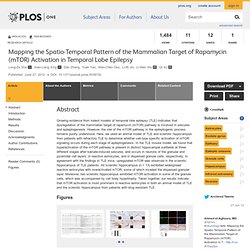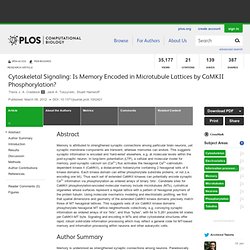

Talks. Google Puts Its Virtual Brain Technology to Work. This summer Google set a new landmark in the field of artificial intelligence with software that learned how to recognize cats, people, and other things simply by watching YouTube videos (see “Self-Taught Software”).

That technology, modeled on how brain cells operate, is now being put to work making Google’s products smarter, with speech recognition being the first service to benefit. Google’s learning software is based on simulating groups of connected brain cells that communicate and influence one another. When such a neural network, as it’s called, is exposed to data, the relationships between different neurons can change. That causes the network to develop the ability to react in certain ways to incoming data of a particular kind—and the network is said to have learned something. ExtremeTech. Immortality for Humans by 2045.
A Russian mogul wants to achieve cybernetic immortality for humans within the next 33 years.

He's pulled together a team intent on creating fully functional holographic human avatars that house our artificial brains. Now he's asking billionaires to help fund the advancements needed along the way. Top 5 Scariest Bioweapons: Photos The man behind the 2045 Initiative, described as a nonprofit organization, is a Russian named Dmitry Itskov. The ambitious timeline he's laid out involves creating different avatars. Gizmag's Dario Borghino wisely warned that "one must be careful not to believe that improbable technological advances automatically become more likely simply by looking further away in the future. " Recently Itskov published an open letterto the Forbes world's billionaires list telling them that they have the ability to finance the extension of their own lives up to immortality. Avatar Girlfriend Goes On Date The project's ultimate goal is to save people from suffering and death. Experimental Neurology - Molecular biology of epilepsy genes.
Abstract Multifactorial inheritance is the most important model accounting for the genetic behavior of the common epilepsies.

Important to this model is the concept that many cumulative or synergistic risk genes ultimately lead to a threshold effect. Sophisticated molecular testing indicates that the common epilepsies are very polygenic without evidence of any single gene having even a mild-to-modest risk effect. However, enrichment of copy number variants in cohorts of individuals with epilepsy indicates that certain structural changes in the genome can confer significant risk for epilepsy. The mechanisms whereby copy number variants confer this effect are not yet known. Highlights Keywords. Neuropsychopharmacology - Cognitive Deficits Caused by Late Gestational Disruption of Neurogenesis in Rats: a Preclinical Model of Schizophrenia. Mapping the Spatio-Temporal Pattern of the Mammalian Target of Rapamycin (mTOR) Activation in Temporal Lobe Epilepsy. Growing evidence from rodent models of temporal lobe epilepsy (TLE) indicates that dysregulation of the mammalian target of rapamycin (mTOR) pathway is involved in seizures and epileptogenesis.

However, the role of the mTOR pathway in the epileptogenic process remains poorly understood. Here, we used an animal model of TLE and sclerotic hippocampus from patients with refractory TLE to determine whether cell-type specific activation of mTOR signaling occurs during each stage of epileptogenesis. In the TLE mouse model, we found that hyperactivation of the mTOR pathway is present in distinct hippocampal subfields at three different stages after kainate-induced seizures, and occurs in neurons of the granular and pyramidal cell layers, in reactive astrocytes, and in dispersed granule cells, respectively. In agreement with the findings in TLE mice, upregulated mTOR was observed in the sclerotic hippocampus of TLE patients.
Figures Editor: Alice Y. Copyright: © 2012 Sha et al. Introduction. Differential Susceptibility of Interneurons Expressing Neuropeptide Y or Parvalbumin in the Aged Hippocampus to Acute Seizure Activity. Updating the hippocampal representation of space: Place cell firing fields are controlled by a novel spatial stimulus - Barry - 2010 - Hippocampus. Cytoskeletal Signaling: Is Memory Encoded in Microtubule Lattices by CaMKII Phosphorylation? Abstract Memory is attributed to strengthened synaptic connections among particular brain neurons, yet synaptic membrane components are transient, whereas memories can endure.

This suggests synaptic information is encoded and ‘hard-wired’ elsewhere, e.g. at molecular levels within the post-synaptic neuron. In long-term potentiation (LTP), a cellular and molecular model for memory, post-synaptic calcium ion (Ca2+) flux activates the hexagonal Ca2+-calmodulin dependent kinase II (CaMKII), a dodacameric holoenzyme containing 2 hexagonal sets of 6 kinase domains.
Each kinase domain can either phosphorylate substrate proteins, or not (i.e. encoding one bit). Neuroscience and philosophy must work together. The brain is made up of a series of interlocking systems.

Photograph: Sebastian Kaulitzki / Alamy/Alamy Human beings are part of nature. They are made of flesh and blood, brain and bone; but for much of the time they are also conscious. The puzzling thing is how the intricate sequences of nerve cells and tissue that make up a person's brain and body can generate the special subjective feel of conscious experience. Consciousness creates, in each of us, an inner life where we think and feel; a realm where we experience the sights, sounds, feels, tastes and smells that inform us of the world around us. Extremely Long-Lived Nuclear Pore Proteins in the Rat Brain. Harnessing Your Marilyn Monroe Neurons. Deep in your brain there are probably several thousand neurons that will respond only to the sight of Lady Gaga.

Several thousand others probably only crackle to the sight of Justin Bieber. It might be nice to reassign those neurons to loftier thoughts. For now, though, neurology can’t help you. What neurology can do for you (if you’re up for a little invasive brain surgery) is let you use those Gaga and Bieber neurons to control a computer. In an unprecedented fusion of pop culture and neurosurgery, scientists at Caltech have invented a surreal brain-machine interface.